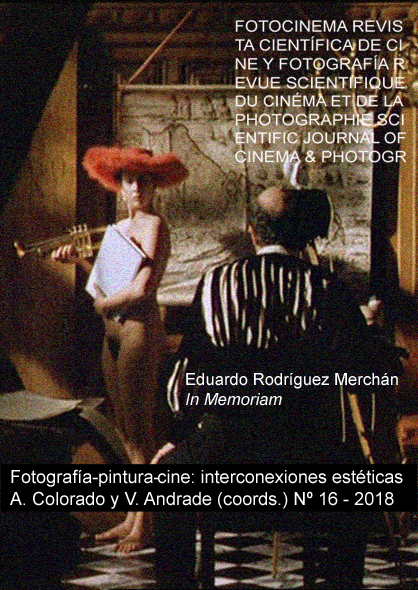Cinema betrays painting: An approach to french film theory from André Bazin and Jean Mitry
DOI:
https://doi.org/10.24310/Fotocinema.2018.v0i16.4087Keywords:
Aesthetic, André Bazin, Film language, Film theory, Jean Mitry, Painting.Abstract
The present work investigates in the analysis carried out by the French cinematographic theory of the middle of century XX on the relation between the pictorial art and the cinematographic art. Specifically, we take into account the work done by the theorists André Bazin and Jean Mitry to verify if the link between cinema and painting has conflicting anchors on the problem of representation. Understanding that both disciplines can be taken not only as transcendental from an artistic profile, but also as generators of meaning processes, it is important to attend to aesthetic, linguistic and philosophical questions to offer an approach to the French line of thought observed in the relationship film-painting various points to discuss. Bazin's thought, based on an ontological theory, and Mitry's exposition, which exposes the condition of cinema as art and language, are key to analyze the transit of the image through various stages of history, from the pictorial representation to the filmic, without forgetting the importance of the emergence of photography, in its dual role of mediator and dissociator, of both periods of the image.Downloads
Metrics
Publication Facts
Reviewer profiles N/A
Author statements
Indexed in
-
—
- Academic society
- N/A
- Publisher
- Universidad de Málaga
References
Arnheim, R. (2001). El poder del centro. Estudio sobre la composición de las artes visuales. Madrid: Ediciones Akal.
Aumont, J. (1997). El ojo interminable. Cine y pintura. Barcelona: Paidós Ibérica.
Barthes, R. (1986). Lo obvio y lo obtuso. Barcelona: Paidós Comunicación.
Bazin, A. (1990). ¿Qué es el Cine? Madrid: Ediciones Rialp.
Benjamin, W. (2003). La obra de arte en la era de la reproductibilidad técnica. Ciudad de México: Editorial Itaca.
Cabot, M. (2016). La crítica de Adorno a la cultura de masas. Constelaciones. Revista de Teoría Crítica, 3, 130-147.
Casetti, F. (2005). Teorías del cine. Madrid: Cátedra.
Casetti, F. y Di Chio, F. (1991). Como analizar un film. Madrid: Paidós Ibérica.
Catalá, J. M. (2011). Reflujos de lo visible. La expansión post-fotográfica del documental. adComunica, (2), 43-62.
Debray, R. (1994). Vida y muerte de la imagen. Barcelona: Paidós Comunicación.
Eco, U. (1986). La estructura ausente. Introducción a la semiótica. Barcelona: Editorial Lumen.
Francastel, P. (1984). Pintura y sociedad. Madrid: Ensayos Arte Cátedra.
Gubern, R. (1996). Del bisonte a la realidad virtual. Barcelona: Anagrama.
León, A. (2016). De la imagen-transparente a la imagen-opaca. Hacia una taxonomía de la imagen fotográfica a partir de la filosofía de Gilles
Deleuze. Estudios de Filosofía, 14, 188-204.
Mitry, J. (1986). Estética y psicología del cine. 1. Las estructuras. Madrid: Siglo XXI Editores.
Mitry, J. (1991). La semiología, en tela de juicio. Madrid: Ediciones Akal.
Palau Pellicer, P. (2012). Ritmo y movimiento en el discurso audiovisual. En Actas del Congreso Iberoamericano de las Lenguas en la Educación (p. 359). Ministerio de Educación.
Stam, R. (2001). Teorías del cine. Barcelona: Paidós Ibérica.
Zunzunegui, S. (2010). Pensar la imagen. Madrid: Cátedra.
Downloads
Published
How to Cite
Issue
Section
License
All contents published in Fotocinema Revista científica de cine y fotografía are protected under the Creative Commons Attribution-NonCommercial-ShareAlike 4.0 International (CC BY-NC-SA 4.0) license. All about this license is available in the following link: <http://creativecommons.org/licenses/by-nc-sa/4.0>
Users can copy, use, redistribute, share and exhibit publicly as long as:
- The original source and authorship of the material are cited (Journal, Publisher and URL of the work).
- It is not used for comercial purposes.
- The existence of the license and its especifications are mentioned.
There are two sets of authors’ rights: moral and property rights. Moral rights are perpetual prerogatives, unrenounceable, not-transferable, unalienable, imprescriptible and inembargable. According to authors’ rights legislation, Fotocinema. Revista científica de cine y fotografía recognizes and respects authors moral rights, as well as the ownership of property rights, which will be transferred to University of Malaga in open access. The property rights are referred to the benefits that are gained by the use or the dissemination of works. Fotocinema. Revista científica de cine y fotografía is published in an open access form and it is exclusively licenced by any means for doing or authorising distribution, dissemination, reproduction, , adaptation, translation or arrangement of works.
Authors are responsable for obtaining the necessary permission to use copyrighted images.














13.png)



